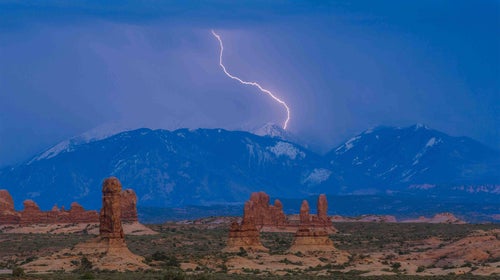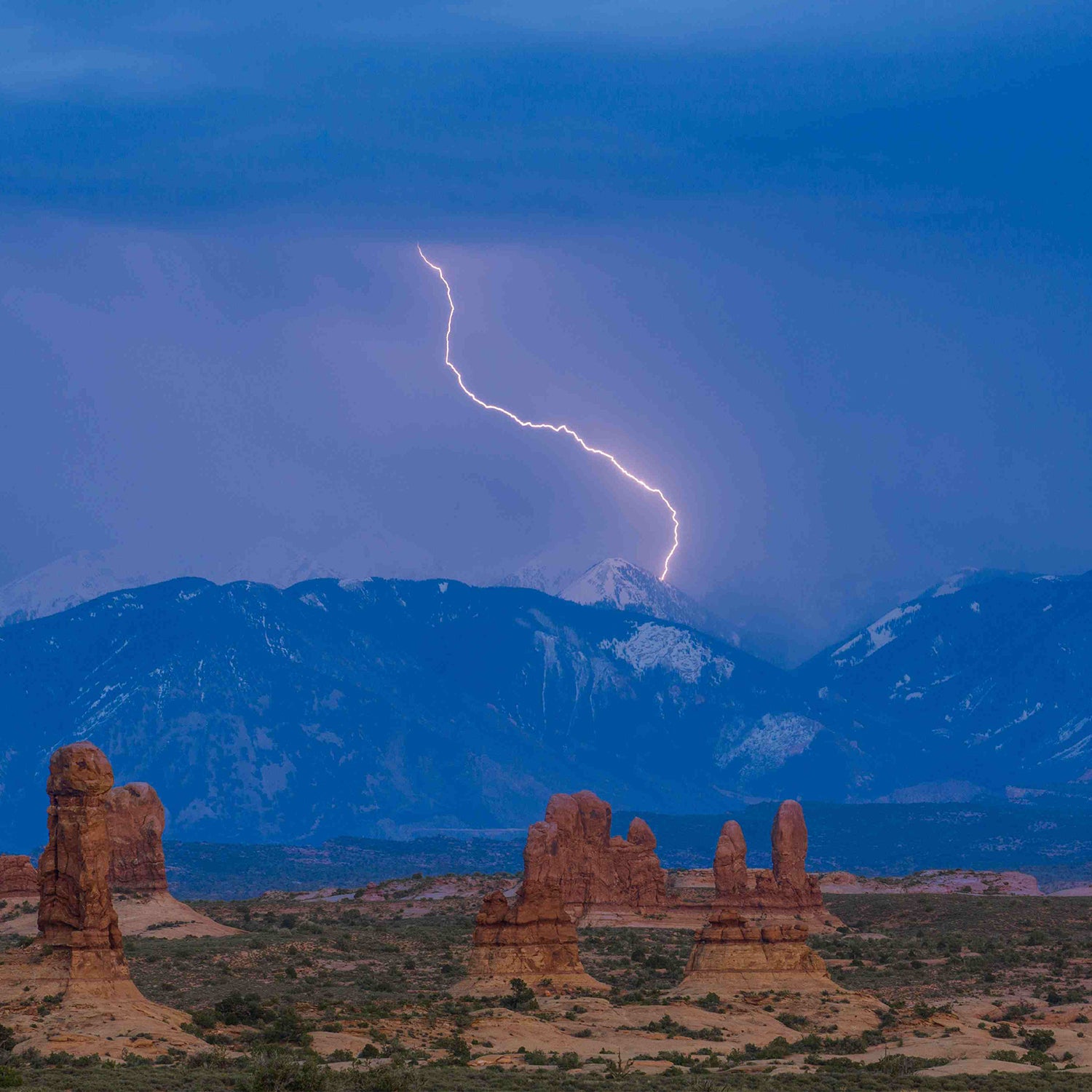About a decade ago, when I first learned about risk management in my college outdoors club, I was taught that assuming the “lightning position” was the best way to protect yourself in a thunderstorm (spoiler alert: it does bugger-all). If you managed to avoid this particular tidbit of backcountry lore, allow me to provide a refresher: the lightning position involves crouching down on a sleeping pad with your heels touching, your chest pressed against your knees, and your hands clamped over your ears. It’s supposed to limit your likelihood of getting electrocuted.
Over the last few years, many outdoor education groups have , now saying the lightning position can only slightly mitigate risk and should only be used as a last resort. But many, including the National Outdoor Leadership School (NOLS), as a way to help insulate your body from ground strikes (it doesn’t). And others, including the Boy Scouts, say can increase your risk of getting struck (another myth).
Few hikers take the time to regularly upgrade their knowledge. That’s because safety research is a total pain. It’s much more fun to authoritatively parrot decades-old adages back to our friends and family (guilty). So, allow me to provide our overdue update. Here’s what’s actually true about lightning safety in the backcountry.
The lightning position is actually bogus.
NOLS teaches that the lightning position is a good option if you find yourself trapped in the open with nowhere else to go. But according to Dr. Ron Holle, a meteorologist and safety specialist for the Lightning Safety Council, that’s not necessarily the case.
“The lightning position is useless,” he says. “There’s a lot of speculative, ‘I suppose this could work,’ sort of advice out there. But I have a file cabinet with about 5,000 cases of people being killed or injured by lightning, and none of those ‘I suppose’ methods work.”
Dr. Kristin Calhoun, a research scientist with the , is inclined to agree.
“If I was in an open field, I wouldn’t assume that position,” she says. “I would run.” Finding lower ground and getting under uniform tree cover are some of the few things that can measurably decrease your lightning risk, she says. She adds that standing or sitting on a sleeping pad “makes no difference” that she’s aware of. Better to leave the pad in your pack and focus on moving to a safer location.
You can get struck by a storm that’s up to 10 miles away.
Many of us have stood on a ridge or mountaintop, seen a storm building in the distance, and told ourselves we still had time. That’s a dangerous misconception, says Calhoun.
“People often don’t worry about a storm until it’s actively raining over them,” she explains. “But it’s often the first flash of lightning that’s the most deadly because people haven’t taken protective action yet.”
Standing under a tree can sometimes be worse than standing out in the open.
Lightning tends to strike the tallest object on a landscape. So, if you’re standing on a tall ridge, your head is that high point (not ideal). But standing under a tall or solitary tree can sometimes be worse. That’s because direct strikes—instances where people get hit directly by a bolt—only account for 3 to 5 percent of all lightning-related injuries. But ground strikes—instances where people are shocked by electricity traveling through the ground—account for up to 50 percent of injuries.
If you’re standing under a tree, you could be at potentially greater risk than if you were standing out in the open. That’s because lightning is more likely to hit a 100-foot-tall tree than a 5-foot-tall person. And if it does, the hiker beneath it is first in line for the aftershock.
“If lightning hits the tree, the ground current will go down through the tree and then back up through the ground,” Calhoun explains. If you’re far from the trunk, the electricity may have time to disperse before it gets to you. But if you’re right next to it, you’ll get the brunt of the shock. Calhoun’s recommendation: find a large patch of shorter trees of uniform height to stand under instead.
Metal doesn’t actually attract lightning.
“Lightning is not attracted to metal,” Holle says. “It travels through metal, but it’s not attracted to it.” Lightning is only attracted to three things, he says: tall structures, isolated structures, and pointed structures. “It doesn’t matter if those structures are made of metal or wood.”
That said, if lightning hits a structure because it’s tall, the metal material may conduct the lightning to the ground more quickly and therefore more powerfully than if it were wood or plastic. So, if you’re at a campsite with a bear-hang pole, try not to pitch your tent near it.
“The metal can conduct electricity, which can jump to a tent 10 to 20 feet away,” Calhoun says.
Crouching can help—but lying down makes things worse.
Crouching reduces your likelihood of being the tallest point on a landscape. But, paradoxically, lying down puts you in even more danger than standing up. That’s because when you’re lying down, you maximize your contact with the ground. That makes ground strikes more likely to affect you. It also makes it more likely that a ground strike could enter your body through a foot and exit through your arm or neck—arcing through your heart along the way.
A tent provides no shelter from lightning.
“There are only two real places you’re safe from lightning: in a real building with wiring or plumbing, which creates a effect, or in a metal-topped vehicle,” says Ron Holle, a meteorologist. A tent, however, provides no shelter.
“Since 2006, more people have died [from lightning strikes] while camping in tents than while hiking by themselves,” Calhoun says. “You also see these horrific accidents where numerous people are injured at once because they’re in a confined area that gets struck.”
So, if you’re pitching a tent, put it somewhere you wouldn’t mind standing in a storm: below treeline, away from tall ridges, and ideally between stands of uniformly tall trees.
Hiding in a cave is a bad idea.
If you’re caught in a storm and encounter a dry cave or rocky overhang, you might think it a gift. Think again, Calhoun says.
If the electrical strike is traveling along the edge of a cliff and encounters the mouth of a cave, it’s not going to take the trouble to travel around the roof of the cave to the floor. Instead, it’s going to jump to you, and use your body as a shortcut. Sheltering from the rain might sound nice, but it’s better to keep moving.
There’s no such thing as getting “accidentally” caught in a storm.
“You weren’t ‘caught’ in a storm,” Holle says. ‘There was some error in your decision making.”
Modern weather forecasting is extremely accurate, he explains—as long as you check the weather for your trail or peak, not for the nearest town. If the forecast calls for some chance of a storm, there’s no excuse not to heed it. “But over and over again, I see people plan for a specific hike or fourteener or whatever, and they feel like they have to go on the day they’ve set aside,” he says. Summit fever is a big problem. And Holle suspects that people on average have less respect for lightning now than they did 10 or 20 years ago.
“There are so many more people doing these activities,” he said. “There’s a new generation coming up that needs to be reminded of the risks.”
Bonus: Lightning Fun Facts
Lighting may be dangerous, but it’s also one of nature’s greatest wonders. Once you get to safety, feel free to sit back and marvel.
- Lightning always causes thunder—even if you don’t hear it. When lightning strikes, the air around the bolt heats up and expands so fast that it sends air molecules shooting outward in every direction. This heat-induced shockwave creates the sound we know as thunder. And it’s there even if you don’t hear it. “Heat lightning,” for example, isn’t silent or special—it’s just .
- Different types of lightning sound different. A short, quick bang means a fast, cloud-to-ground flash happened nearby, says Calhoun. But a long, continuous rumble means lightning is arcing more horizontally. Each beat of the rumble is the sound of a leader breaking off from the main streamer and forking away from you through the sky.
- A single bolt of lightning can cover a whole state. Geostationary satellites often measure bolts that are hundreds of miles long. In 2021, researchers recorded one that was and stretched across parts of Texas, Louisiana, and Mississippi.
- Volcanoes can also cause lighting. Clouds of exploding volcanic dust can also build up electric charge. (So can tornado and hurricane clouds.) Often, the charge is sufficient to over an erupting volcano.
- Lightning helps fertilize the soil. Lightning tears through the air with enough force to . That leaves nitrogen atoms free to combine with oxygen, creating molecules called “nitrates” that are essential for soil and plant health.


